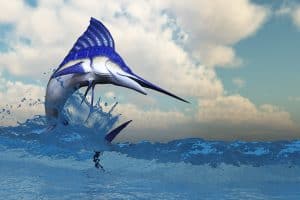Blue marlin is widely known as an excellent fish for sport fishing, due to its potential size, strength and aggressiveness when hooked. But after you reel it in, can you eat blue marlin? Do to it being endangered, there is quite some controversy around this topic.
Purely going by if it is possible and if it tastes well, yes you can eat marlin and it can taste great. But let’s have a look at it in more detail.

About Blue Marlin
Similar in appearance to a swordfish, its beak is probably this predator’s most defining characteristic followed by its two dorsal fins. They use it to stun and kill their prey. Marlins can grow absolutely huge to weigh almost 2,000 pounds, though most are in the low three digit pounds when caught. Which is still a lot by any means.
Most common in the Atlantic and to a lesser extent the Indian Ocean, they are migrating and following warm currents. Blue Marlins, sometimes also called billfish or ocean gar, do not have many natural enemies outside of the biggest sharks and obviously humans.
How does Blue Marlin Taste?
Blue Marlin have a strong texture, almost more comparable to meat than most other fish. Similar to fatty tuna, steaks from this fish contain a high amount of fat and thus taste.
Due to it being somewhat chewy, in combination with its oily texture, some people find marlin to be gamey. Others love it for the same reasons. As so often, it comes down to personal preference.
Can You Eat Blue Marlin?
In short, yes you can eat blue marlin. Keep in mind though, that within 200 miles of US coastline, any billfish caught are required to be released back into the ocean. The same rules are not applied in many other countries, however.
Are blue marlin good to eat though? Considering their shrinking numbers and relatively high mercury levels, it would be best to look for alternatives instead. Halibut and sturgeon are recommended as substitutes for marlin.

Can You Eat Marlin Raw?
You definitely can eat blue marlin raw. In fact, it is considered a delicacy in Japanese cuisine, served raw as Sashimi with only optional condiments like soy sauce, wasabi paste and ginger.
Nevertheless, you have to be certain of its freshness and origin. When in doubt, fillet and cook the fish well before consumption!
Is It Safe to Eat Blue Marlin?
It is generally safe to eat blue marlin, though as with basically any kind of food, moderation is the key. As blue marlin is a predator and big fish, consequently its mercury levels are elevated compared to other species.
Thus, you might want to reconsider eating a huge amount of marlin and instead opt for a mixture of different fish plus side dishes for your meals. In the same vein, avoid eating fish every day both for your own good and the environment!

Conclusion
If you were asking yourself can you eat blue marlin, then the answer is a clear yes. That being said, the question remains, if you should eat blue marlin.
From a sustainability point of view, there are quite some concerns to be raised here. First, blue marlin is sadly often a victim of bycatch where trawlers are actually on the hunt for different fish as well as longlines and second, its population recovers slowly. With human population continuing to increase and average wealth levels as well, demand for fish as part of our diet continues to increase and might outstrip blue marlin recovery rates.
Make sure to check out our articles on alternative fish to consider eating, e.g.: blobfish, flounder, pike, perch or tripletail.